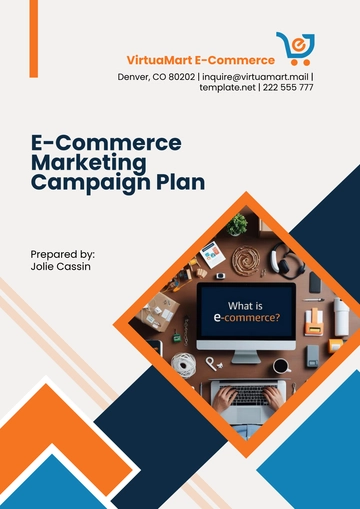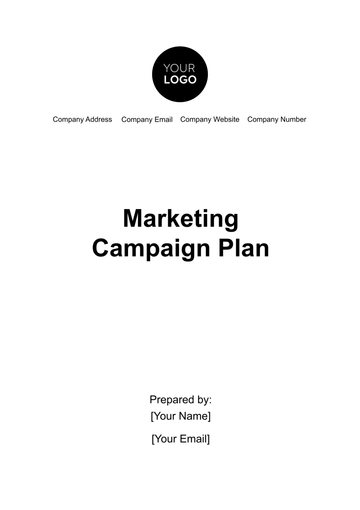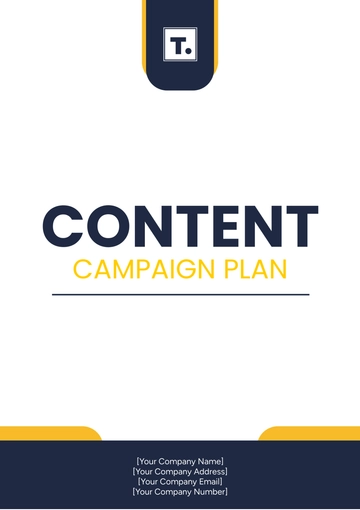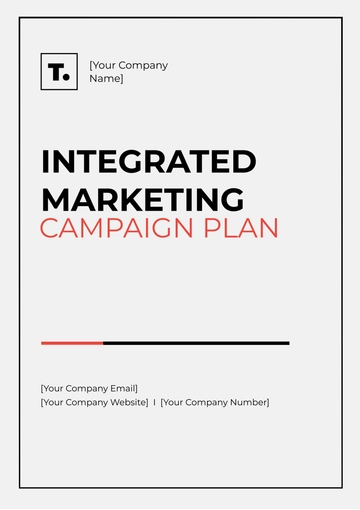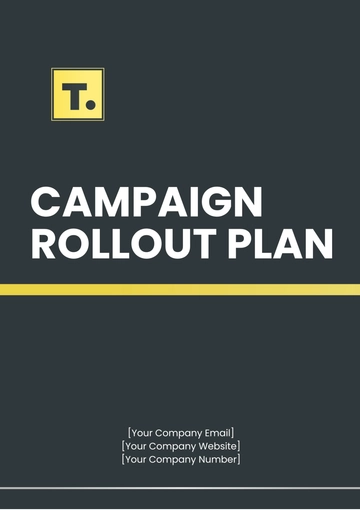Free Email Marketing Active Campaign Plan

I. Campaign Overview
A. Campaign Objectives
The primary goal of [Your Company Name]'s email marketing campaign is to increase sales of a new product line by [00]% over the next quarter. We will also aim to boost engagement by increasing the click-through rate (CTR) by [00]% through targeted email content and segmentation. Our secondary goal is to improve brand awareness through a series of educational emails about the product’s features and benefits.
B. Target Audience
Our target audience for this campaign includes existing customers who have previously purchased similar products, as well as new subscribers who have shown interest in related categories. We will also target individuals aged 30-50 with a focus on those who engage with our emails at least once a month. Through [Campaign Name]’s segmentation, we will categorize leads based on behavior, such as email opens, website visits, and past purchase history.
C. Campaign Type
This campaign will include a mix of promotional and educational emails designed to nurture leads and convert them into paying customers. The promotional emails will highlight limited-time offers and product discounts, while the educational emails will focus on showcasing the new product's unique features. The tone will be friendly yet professional, with a clear call to action in each email.
II. Audience Segmentation
A. Segmentation Strategy
We will segment our audience into the following groups:
New Subscribers | Individuals who joined the email list in the last 30 days. |
Past Customers | Customers who have purchased similar products in the past 6 months. |
Engaged Leads | Subscribers who have clicked on links in the last 30 days but have not yet made a purchase. |
B. [Campaign Name] Segmentation Tools
Using [Campaign Name], we will set up dynamic segments based on specific triggers such as website visits, past purchases, and interaction with email campaigns. For instance, we’ll tag leads who clicked on specific product categories on the website. We will use these tags to personalize follow-up emails based on the products they have shown interest in.
III. Campaign Workflow & Automation
A. Automation Strategy
The automation will begin with a welcome sequence for new subscribers, followed by a nurturing sequence for past customers. We will use [Campaign Name] to trigger emails based on specific user actions, such as signing up for the list, making a purchase, or clicking on product links. For engaged leads, we will send a series of 3 automated emails over 7 days, offering product discounts and providing educational content.
B. [Campaign Name] Automation Setup
The automation workflow will look as follows:
Day 1 | Welcome email for new subscribers. |
Day 2-5 | Product highlight emails with links to the product page. |
Day 6 | Offer email with a discount code for a limited time. |
Day 7 | Reminder email about the discount offer. Using [Campaign Name]’s tagging system, emails will be triggered based on past interactions (e.g., if they’ve clicked on a product or made a purchase). |
C. Lead Scoring and Tracking
Leads will be scored based on their interactions with the emails:
Clicking on product links = +5 points
Making a purchase = +20 points
Opening emails regularly = +2 points per email
This scoring system will allow us to prioritize leads who are most likely to convert and send them tailored offers.
IV. Email Content Strategy
A. Email Types
The campaign will consist of:
Welcome Emails | Introduction to the brand and product offerings. |
Educational Content | How-to guides or tips about the product. |
Promotional Emails | Discount offers and product announcements. |
B. Content Creation
The welcome email will introduce our new product line and explain its benefits. For the educational emails, we will focus on answering common questions and showcasing customer testimonials. The promotional emails will include a limited-time discount code that’s valid for 7 days. All emails will be designed to be visually engaging with clear calls to action (e.g., "Shop Now," "Learn More").
C. Design and Layout
Each email will follow a clean, mobile-friendly design, with images of the product prominently displayed. We'll use a consistent color scheme aligned with our brand, and each email will feature a bold call-to-action button to drive conversions. The emails will be responsive, ensuring they look great across devices, whether on desktop or mobile.
V. A/B Testing & Optimization
A. A/B Testing Strategy
We will test:
Subject Lines | Testing two different approaches: a more straightforward approach (“Exclusive 20% Off New Products”) vs. a curiosity-based approach (“You Won’t Want to Miss This”). |
CTA Buttons | Comparing “Shop Now” with “Get Your Discount” to see which drives more conversions. |
Email Copy | Testing short vs. detailed descriptions to see which format leads to higher engagement. |
B. [Campaign Name] A/B Testing Features
We will set up A/B tests using [Campaign Name]’s built-in tools, which will split the email list into groups and send different versions of the same email. We will analyze open rates, click-through rates, and conversion rates to determine which version performs better and adjust the rest of the campaign accordingly.
VI. Timing & Frequency
A. Email Send Schedule
The emails will be sent on the following schedule:
Welcome Emails | Immediately after a new subscriber joins. |
Product Emails | Sent every 3 days during the first 2 weeks. |
Offer Emails | Sent once, 3 days before the promotion ends. Based on previous campaign performance, emails will be sent at 10 AM local time to maximize open rates. |
B. Email Cadence
The sequence for new subscribers will be:
Day 1: Welcome Email
Day 3: Product Introduction
Day 5: Special Offer Reminder
Day 7: Last Chance Offer
For past customers, the cadence will focus on re-engagement and will be sent bi-weekly for the next month.
VII. Analytics & Reporting
A. Campaign Metrics
Key metrics to monitor:
Open Rate: Target [00]% open rate.
Click-through Rate (CTR): Target [00]% click-through rate.
Conversion Rate: Target [00]% conversion rate.
Unsubscribe Rate: Target below [00]%.
Metric | Goal | Current Benchmark |
|---|---|---|
Open Rate | 30% | 28% |
Click-through Rate | ||
Conversion Rate | ||
Unsubscribe Rate |
B. Post-Campaign Analysis
After the campaign ends, we will analyze the results and identify areas for improvement. For instance, if open rates are lower than expected, we might experiment with different subject lines or send times. Similarly, if conversion rates are low, we’ll review the CTA buttons or promotional offers to make adjustments for future campaigns.
VIII. Compliance & Deliverability
A. Legal Compliance
To ensure compliance with email marketing regulations, our campaign will follow all necessary laws, including GDPR (General Data Protection Regulation) for European customers, and CAN-SPAM (Controlling the Assault of Non-Solicited Pornography And Marketing Act) for U.S.-based recipients. Each email will feature an easily accessible unsubscribe link, ensuring recipients have the option to opt-out of future communications. We will also include a privacy policy link at the bottom of each email to maintain transparency about how customer data is used.
B. Email Deliverability
Our deliverability goal is to ensure that at least [00]% of emails reach the inbox and don’t land in spam folders. To achieve this, we will regularly clean our email list to remove inactive subscribers and ensure that all recipients have explicitly opted in. We will monitor sender reputation using [Campaign Name]’s deliverability tools and adjust our sending practices if we notice high bounce rates or complaints. Additionally, we'll include double opt-ins for new subscribers to confirm their intent to receive emails.
IX. Follow-Up and Re-Engagement
A. Engagement Tracking
We will use [Campaign Name]’s engagement tracking tools to monitor how subscribers interact with our emails. This includes tracking who opens the emails, who clicks on links, and who makes a purchase. Based on this data, we will set up follow-up triggers to send targeted emails to users who engage with the content but don’t complete the desired action, such as making a purchase or redeeming an offer.
For example:
Engaged but not converted: Subscribers who clicked on product links but didn’t purchase will receive a follow-up email with a special discount code or product review.
Unengaged: Subscribers who haven’t opened emails in the last 30 days will be sent a re-engagement email with an exclusive offer or a “we miss you” message.
B. Re-Engagement Campaigns
For subscribers who become inactive (e.g., not opening emails for 60 days or more), we will initiate a re-engagement campaign to try and bring them back into the fold. The re-engagement email will offer a significant incentive, such as a [00]% discount or a freebie, and ask for feedback on why they may have stopped engaging. If there’s still no interaction after this series, we will consider removing them from the active list to maintain the health of our email marketing efforts.
X. Continuous Improvement
A. Iterative Testing and Tweaking
One of the core principles of email marketing is continuous improvement. After each campaign, we will review the performance data, including open rates, click-through rates, conversions, and unsubscribe rates, and identify areas for improvement. For example, if subject lines consistently have lower open rates, we might experiment with more engaging or personalized subject lines. We will also optimize sending times based on the highest engagement patterns identified.
[Campaign Name]'s reporting and A/B testing features will allow us to experiment with new elements and constantly refine our email strategy. We will keep track of test results (e.g., subject line testing, design changes) and incorporate successful strategies into future campaigns.
B. Ongoing Education
To ensure our campaigns stay relevant and effective, we will regularly participate in webinars and training to stay updated with new features and industry trends. We will also monitor competitor campaigns to gather insights and inspiration for our email marketing strategy. Additionally, as [Campaign Name] introduces new features, we will evaluate their potential for enhancing our email marketing efforts—whether it’s advanced segmentation, AI-powered suggestions, or new automation templates.
XI. Conclusion & Action Plan
This Email Marketing Active Campaign Plan is designed to streamline our efforts, increase conversions, and nurture meaningful relationships with our audience. By leveraging [Campaign Name]’s powerful segmentation, automation, and personalization tools, we will ensure that our emails resonate with subscribers and drive action. Our next steps are as follows:
Segment the audience based on purchase history, engagement levels, and demographics.
Create email content for welcome, promotional, and educational emails.
Set up automation workflows for each segment and ensure trigger actions are correctly configured.
Test and optimize campaign elements regularly using [Campaign Name]’s A/B testing tools.
Monitor performance and iterate based on the campaign analytics.
We are confident that this plan will deliver strong results in terms of engagement, conversions, and customer retention. By using data-driven insights, personalized content, and efficient automation, we will optimize our email marketing to grow our customer base and drive revenue.
- 100% Customizable, free editor
- Access 1 Million+ Templates, photo’s & graphics
- Download or share as a template
- Click and replace photos, graphics, text, backgrounds
- Resize, crop, AI write & more
- Access advanced editor
Manage your email marketing campaigns effortlessly with the Email Marketing Active Campaign Plan Template from Template.net. This editable and customizable template allows you to tailor your strategies to suit your unique business needs. Easily update content using the powerful AI Editor Tool, ensuring your campaigns are both effective and professional. Perfect for any marketing team!
You may also like
- Finance Plan
- Construction Plan
- Sales Plan
- Development Plan
- Career Plan
- Budget Plan
- HR Plan
- Education Plan
- Transition Plan
- Work Plan
- Training Plan
- Communication Plan
- Operation Plan
- Health And Safety Plan
- Strategy Plan
- Professional Development Plan
- Advertising Plan
- Risk Management Plan
- Restaurant Plan
- School Plan
- Nursing Home Patient Care Plan
- Nursing Care Plan
- Plan Event
- Startup Plan
- Social Media Plan
- Staffing Plan
- Annual Plan
- Content Plan
- Payment Plan
- Implementation Plan
- Hotel Plan
- Workout Plan
- Accounting Plan
- Campaign Plan
- Essay Plan
- 30 60 90 Day Plan
- Research Plan
- Recruitment Plan
- 90 Day Plan
- Quarterly Plan
- Emergency Plan
- 5 Year Plan
- Gym Plan
- Personal Plan
- IT and Software Plan
- Treatment Plan
- Real Estate Plan
- Law Firm Plan
- Healthcare Plan
- Improvement Plan
- Media Plan
- 5 Year Business Plan
- Learning Plan
- Marketing Campaign Plan
- Travel Agency Plan
- Cleaning Services Plan
- Interior Design Plan
- Performance Plan
- PR Plan
- Birth Plan
- Life Plan
- SEO Plan
- Disaster Recovery Plan
- Continuity Plan
- Launch Plan
- Legal Plan
- Behavior Plan
- Performance Improvement Plan
- Salon Plan
- Security Plan
- Security Management Plan
- Employee Development Plan
- Quality Plan
- Service Improvement Plan
- Growth Plan
- Incident Response Plan
- Basketball Plan
- Emergency Action Plan
- Product Launch Plan
- Spa Plan
- Employee Training Plan
- Data Analysis Plan
- Employee Action Plan
- Territory Plan
- Audit Plan
- Classroom Plan
- Activity Plan
- Parenting Plan
- Care Plan
- Project Execution Plan
- Exercise Plan
- Internship Plan
- Software Development Plan
- Continuous Improvement Plan
- Leave Plan
- 90 Day Sales Plan
- Advertising Agency Plan
- Employee Transition Plan
- Smart Action Plan
- Workplace Safety Plan
- Behavior Change Plan
- Contingency Plan
- Continuity of Operations Plan
- Health Plan
- Quality Control Plan
- Self Plan
- Sports Development Plan
- Change Management Plan
- Ecommerce Plan
- Personal Financial Plan
- Process Improvement Plan
- 30-60-90 Day Sales Plan
- Crisis Management Plan
- Engagement Plan
- Execution Plan
- Pandemic Plan
- Quality Assurance Plan
- Service Continuity Plan
- Agile Project Plan
- Fundraising Plan
- Job Transition Plan
- Asset Maintenance Plan
- Maintenance Plan
- Software Test Plan
- Staff Training and Development Plan
- 3 Year Plan
- Brand Activation Plan
- Release Plan
- Resource Plan
- Risk Mitigation Plan
- Teacher Plan
- 30 60 90 Day Plan for New Manager
- Food Safety Plan
- Food Truck Plan
- Hiring Plan
- Quality Management Plan
- Wellness Plan
- Behavior Intervention Plan
- Bonus Plan
- Investment Plan
- Maternity Leave Plan
- Pandemic Response Plan
- Succession Planning
- Coaching Plan
- Configuration Management Plan
- Remote Work Plan
- Self Care Plan
- Teaching Plan
- 100-Day Plan
- HACCP Plan
- Student Plan
- Sustainability Plan
- 30 60 90 Day Plan for Interview
- Access Plan
- Site Specific Safety Plan






